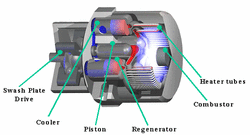
www.squidoo.com/robert-stirling
Rev. Robert Stirling the inventor of the Stirling Engine.
History of the Stirling Engine

thefraserdomain.typepad.com
Rev. Robert Sterling filed for the patent of the his external combustion engine in 1817, in England. The idea behind it was that it would be more efficient at converting fuel into energy and by not having the moving parts of the machine in direct contact with the combustion chamber, it would be more reliable. The engine had a hot and a cold side, where two pistons were interconnected in such a way that as the heat from the combustion chamber heated up the gas(air or inert gas) in the expansion side of the engine, it expanded and forced the piston to be moved, while on the cold side of the engine with the use of a heat exchanger, heat is removed causing the volume of the driving gas to be reduced. With the use of a regenerator, where the hot gas is used to pre-heat the cooled gas in order to improve the efficiency of the machine, the heating and cooling action, forces the pistons to drive back and forth attached to a crankshaft and flywheel assembly which in turn allows heat energy to be converted in to useful mechanical energy.
At the time of Sterlings invention, the steam engine was the primary competition as the industrial revolution was underway. Challenges with reliability due to materials that were available at the time probably ended up being the primary reason for it not taking a greater role like the steam engine. Failure of parts, do to metal fatigue and improvements to steam engines helped lead to the obscurity of the Stirling engine. Around a hundred years later, it resurfaced again, but with the emergence of the internal combustion engine, it was unable to gain popularity. In the 1940's Philips, spent considerable money on research to improve the Stirling engine with advances in metallurgy the company thought it would be possible to build a quieter and more energy efficient engine, but by the end of WWII, efforts were abandoned. There have been attempts to build and use small scale 3-5kW sterling designs in underdeveloped countries for use with biomass, but cost has been prohibitive to getting wide spread acceptance and commercialization. By the 1970's as energy prices for fossil fuels climbed, there was renewed interest in the possibilities for the Sterling engine. As there have been advances in solar, nuclear, and biomass technologies there has been a renewed interest in the possibilities of an external combustion engine. Today, there has been many years and large sums of money invested in research as some companies are bringing sterling engines to the market in countries like Denmark, Germany, the Netherlands, Japan, and the US. The majority of the companies are marketing their projects for large scale production for use in waste heat recovery(50-300kW) to 500-1000MW solar production facilities.